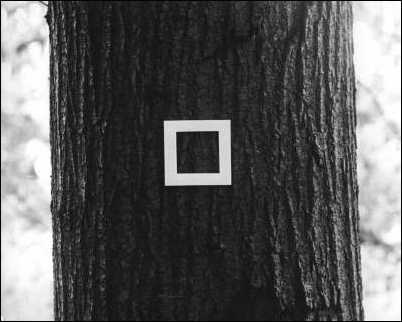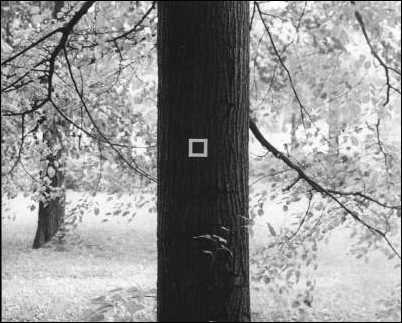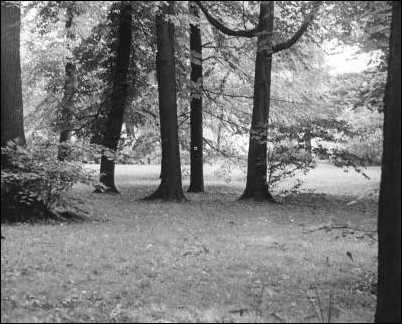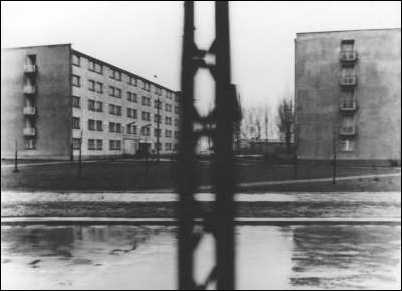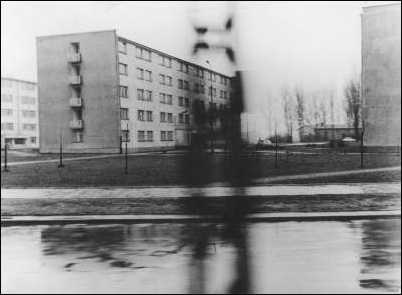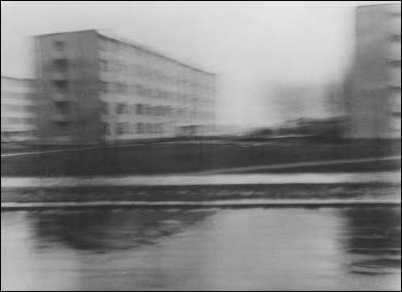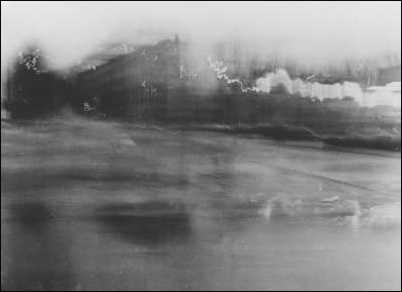december 1995
Foto © Ryszard Wa¶ko. From the series: Reduction - Enlargement - 1976
Ryszard W. Kluszczyński
Trans-media Art. On the Art of Ryszard Wa¶ko.
Art of the seventies causes different reactions nowadays. However, opinions concerning it too often result not from scrupulous studies, but from individual, extremely subjective views or even preferences. Some critics, connected spiritually with the paradigm of the sixties, constructed from very selectively (or too selectively, I should say) chosen elements, reject the different, radical, "not elegant" and iconoclastic works of the artists, who shaped the art of the next decade. Alas, they do not do it in a way that would clearly state that they prefer one kind of art over another because it is, for some reasons which could be verbalized, closer to them, but instead they claim that only the first one is real avant-garde art, while the second one is worthless. Such lack of respect for the critical workshop does not let us treat these opinions seriously. Other critics discredit the art of the seventies for political reasons, claiming that the artists of that decade gave an alibi to the quasi-modernist ideology proclaimed by the political leaders at that time. However, one cannot accept those views; either, as they deconstruct themselves: more often than not their supporters gained their knowledge and education in that very same decade they criticize, which leads to the conclusion that neither their knowledge nor their scholarly abilities are reliable. And let us not forget that studying diligently(?) in the seventies they allowed our political administration to create a false image of Poland as a modern country with a highly educated society. But, seriously speaking, one should observe that all such opinions are formed regardless of any deeper studies of the decade, i.e. without factual knowledge of Polish art in the nineteen seventies, of its important and lasting achievements in the Polish artistic reality.
There is an urgent need to recognize this artistic period in Poland and to verify too many hastily formed opinions - we need to lay solid foundations for future syntheses. Many important exhibitions have not as yet found their organizers, many important artistic accomplishments are still waiting for their discoverers, and many artists for their monographs. We are near the end of the century, the time for final summaries is arriving, and no history of modern Polish art will be able to do without an adequate, faithful presentation of the seventies.
1.
Ryszard Wa¶ko is one of those artists whose creative attitude was shaped in the nineteen seventies. His work was a part of that decade and helped to form Polish art in the following years. Unconventionality and radicality of his works is still a challenge to modern art historians because they demand equally unconventional methods of interpretation. A scholar analyzing artistic events in Poland of the last twenty five years, who might try to describe and interpret Wa¶ko's work by placing it in the space marked by any of the artistic genre categories, would have to admit quickly that such an attempt is completely futile. Wa¶ko's works are not limited to any of the artistic genres he uses because they easily cross the borders between them: And his individual realizations, even if they reamin - due to the materials used and some general genre manifestations - within a certain kind of art, they still cannot be explained by referring to the characteristics of that branch of art which is realized in them. On the contrary, quite often the fundamental principles which make up the structure of the artefacts come from a different branch of art than the one in which the works were actually created and where we would be inclined to place them.
This suggestion leads us to a hypothesis, which I shall try to develop in this essay, that the character of Ryszard Wa¶ko's work in general, as well as the character of his individual works, is often defined by inter-generic, inter-media relations. Those works set in motion a whole net of intertextual relations on the level of general structural and ontological determinants, and on the level of different types of perception and rules of interpretation. In other words, in order to grasp a work which belongs to a certain artistic genre in its specificity, one should refer to its non-specific features which are characteristic for another kind of art.
Another hypothesis I would also like to explain here says that if a work by Ryszard Wa¶ko belongs to a different kind of art than film, it is precisely film which plays the role of the "intertext" with regard to the work. In such a case we might also want to examine how the process of intertextual references is realized with regard to films.
2.
As the rust example let us take a photograph, or rather a photographic construction called The Accident (a police record) from 1971. This work transgresses the standard of a photographic presentation through the multiplication of the picture. But it is not the most important fact here. Not one of the individual photographs making up the whole work presents the whole of the title event - they show only particular details. But putting those fragmentary presentations together also does not form the whole picture. The potential whole here is a mental image, a notion. We do not see the photograph from a definite, external position, which may be considered to be a perception perspective specific for this medium, but, like film viewerswe are placed within the world presented. Our looks are not located or fixed in one point, but they are subordinated to the edited structure and thus they move from one place to another. But unlike in the case of a film this change of the vantage point is not developed in a linear way - it moves in many directions and it is not limited in time. In a film we have to do with a few time levels: the level of the time of the film itself, the level of time of the presented world (diegetic time), and the time of perception. The Accident using cinematographic conventions places them within the temporal order of photography, where we actually have to do only with the time of perception. This is where the aspect of infinite presentation characteristic for this work and its static-dynamic order spring from.
Many other photographic works consisting of many elements and created in the first half of the seventies in a similar, but not identical way, transcends the determinants of the medium. From O° to 180° (1971) is a photograph which joins into one a series of pictures that somehow represent the movement of a human bead being raised from the earth to the sky by means of a constant, linear movement of the point of view of the camera. Movement is also inherent in the structure of a series of works entitled A Four-dimensional Photograph (all from 1972). In the first work six horizontally placed photographs presenting a city landscape reveal the growing disturbance (motion) which is introduced into the static photograph by movement and thus - by the element of time. In the second work of the series an abstract graphic element - a line, which replaced the representation of an object - undergoes the same process that was described above.
Foto © Ryszard Wa¶ko. From the series: A Four-dimensional Photograph.
In a few other photographic works which came into being in the middle of the decade Wa¶ko continued to manipulate spatial structures in relation to the perception process. Reduction - Enlargement - Attempt (1975) or The Listing of Space Using Numbers 1-8 (Attempt II), created in 1976, are examples of other works in which multiple photographic systems situate the observer in a sequence of ever changing vantage points, but always in the same space. The viewer is usually placed within the world he observes, not in some distant, external position. And always - as in the works discussed above - the overall vision is created by the imagination of the observer; it is not simply the object of his vision.
All the works described until now are characterized by a deconstructive attitude towards the medium in which they are created - i.e. photography, whose borders and determinants are problematized, but the works still remain within the limits of the medium. It is possible mainly due to the fact that the deconstruction of photography takes place using the attributes of the film medium which is a development of the medium of photography. Film determinants, such as time and movement, disturb and transform the photographic order of Wa¶ko's works. The intertextual connection of photography and film deconstructs the former, defining at the same time the character of individual works.
This character is different in works where photography is elongated and transformed by drawings. A Hypothetical Photograph (1977) is a series of illustrations, the first one of which is a photograph: a city landscape that changes into an abstract form by means of a drawing (contour lines are drawn around objects, creating "diagrams") projected in a series of nine other illustrations. The deconstruction of photography turns to abandonment of photography in this work. In Enlargement - a work created one year earlier - graphic structures enter into the structure of photography disturbing the relation of representation. The origins of this kind of experiments may be found in a work from 1972 called The "n " Chair. The photograph used in this work was also disassembled and transformed into an abstract arrangement.
In all the discussed works we can also observe a conflicting tension between artistic and meta-artistic language. The energy released in this reaction possesses both a deconstructive and cognitive aspect. The object of Wa¶ko's deconstructive analysis is the nature of the medium. In the case of photography we have to do with the problems of relation between the picture-representation, the object and reality. All the symptoms of meta-artistic reflection accompany the intertextual discourse which builds a system of various inter-media relations. Together they form a net of references, derivations and transgressions determining the situation of art remaining in the process of constant border transgression, art which constantly rejects its old spheres and forms, art which rejects itself.
3.
In the seventies besides photography Ryszard Wa¶ko was also interested in film-making. He was one of the first members of the Film Form Workshop, the most important formation of avant-garde cinema in post-war Poland. The group was founded in 1970 by the graduates (teachers) and students of the Film School in Lodz. In spite of its cinematic origins and its name the Film Form Workshop possessed a decidedly polymorphic nature, as the members of the group were not only directors or cameramen, but also photographers, plastic artists, musicians and poets. The open nature of the Workshop allowed all of them to find their place in its programme, especially because many of their artistic endeavours were clearly closely related to happenings or performances.
Ryszard Wa¶ko became a Workshop member in 1971. The following year he made his first films within the programme of the FFW. He quickly became one of the most prominent artists of the group. He took part in numerous presentations of world avantgarde cinema of the decade, such as, for example, "International Experimental Film Festival" in Knokke-Heist (1974), "Film als Film" in Kolnischer Kunstverein (1977) or "Film as Film" in Hayward Gallery in London (1979).
Wa¶ko's films, like his photographs, combine an analytical attitude (towards the medium) with the intertextual tendency to trangress the genre borders. The Padlock (1972) develops a non-cinematic narration by means of referring to photography (motionless, static frames impose this feature on cinematic images). Registration (1972) is based on space manipulation, constructing by means of counterpoint use a series of pictures engaging the imagination of the viewer and deceiving him finally by the vision of an impossible space. This film (like the photographic work The Accident, discussed earlier) tries to place the viewer within the constructed space. This time it operates in accord with the nature of the medium, even though the construction of the discourse has much in common with photography. The Wall (1972) transforms a direct film registration through its non-chronological editing (after cutting it into very short pieces) and through sound counterpoints. In The Sidewalk (1972) Wa¶ko again uses the intertextual reference to photography because movement appears there as a result of connecting and dividing static images created by means of ones animation. System I-VI (1973) is an analysis relations between pictures and sound, which, by the way, plays the role of media intertext in many films by Wa¶ko and other artists centred around the Film Form Workshop. The film 30 Sound Situations (1975) which, in turn, studies those relations in reference to perception rather than to ontology of the film. In all those works by Wa¶ko, as well as in those I have not mentioned, one can notice clearly analytical interests in the spatial dimensions of the cinema. I Walk Between (1975) ultimately leads the cinema in the sphere of performance art (to a lesser degree it was also attempted in his other films, like in the aforementioned 30 Sound Situations). It is only one of the many roads which Wa¶ko's cinema takes to leave its original realm. The analytical attitude which has a lot to do with conceptualism and structural cinema concentrates its attention primarily (if not exclusively) on media determinants and it neglects not only expression, but also form conceived objectively. It concerns both film and photography in the same degree. In Wa¶ko's works created in these two media the objects gradually disappear from the pictures and images. The function of representation is replaced in them by an abstract analytical discourse. A lot of works and photographic and cinematic projects have been devoted totally to discussions of problems that are of interest to him, such as, for example, the question of relation between the plane (of a photograph or the screen) and space.
The cinema of Ryszard Wa¶ko, like his photographs, is stretched between the internal analysis of the medium, the study of its mathematical logic, and the external analysis of its relations and connections. Photography found its intertext above all in the film medium, while external intertextual functions in the case of film are filled by different media that are also present (in various ways and to various degrees) in cinematic structure: photography, sound art and performance are examples of these artistic disciplines. Their active presence within and without the medium of film problematizes the opposition between "the inside" and "the outside", making transgression and transmedializm the essential features of works by Ryszard Wa¶ko.
4.
His video works occupy a similar place within the realm of art. In his installation Corner (1976) he problematized the phenomenon of direct transmission, analyzing simultaneously the relation between reality and its representation, between real space and presented space. Another important aspect of this work is the spatial character of the installation itself (the monitor) - it is a point where real space meets the representation of space, so the installation not only deconstructs the medium of video, but it also comes into an intertextual relation with sculpture and environment art. The problem of presented space in video art, this time in an intertextual relation not only to spatial arts, but also to performance art, returns in Wa¶ko's video-performance-installation called The Space Beyond (1976). His video-performance (created in the same year) entitled The Fatigue of My Leg draws our attention to the position of the artist as the subject of unintentional intrusions in the structure of the work - which also presents the work itself (in accord with McLuhan's ideas) as the extension of human psychophysiological activity. The problem of the intrusion of the medium in the structure of the work Wa¶ko examines in another work called Enlargement (1976).
Foto © Ryszard Wa¶ko. Installation: Corner.
Some of his video works of the seventies, like, for example, Measurement (1976), were extensions of his earlier film experiments. Most of them combined the continually present in them transmedia perspective with the analysis of the features of the new creative instrument -video. However, all of them were open, both structurally and notionally - they were consecutive stages of a mental process within the limits of which various aspects of the medium were analyzed.
5.
It would seem that photography, film and video were basic creative instruments for Ryszard Wa¶ko. However quite early in his career, at least in 1977, one might clearly notice signs of transformations in Wa¶ko's works (the artist himself believes his turning-point work to be Model 50 50, created in 1976). In the second part of this essay, when writing about his 1977 work Hypothetical Photograph, I said that the deconstruction of the medium becomes its gradual rejection. Other works of the same kind followed: a second version of Hypothetical Photograph (1978), a series of works under a common title Hypothetical Film (1979.). The artist rejects the media he bad been employing until now and reaches for new means of expression, he moves away from technology and from the danger of being enclosed in one particular style. But he does not do away with his earlier attitude which basically may be described as an inclination towards elementary qualities. Among other features of his work that survived th crucial time of change (proving their importance) one should mention space, time, movement, dynamics, Iight, fragmentation, incompleteness, inconclusiveness, transformation, transgression and transmedialism. The works created in this paradigm escape general perception - the whole is elusive, but, on the other hand, it is necessary to understand the details we perceive. What is necessary is then the intrusion of structural imagination (this aspect of his works is fundamental for all artistic projects related to conceptual strategies). The position of the audience becomes dynamic and the gradual nature of perception corresponds to (at least for the time of perception) the structure of the work which takes on an analogous shape.
Not only his contemporary works, but also works from the eighties contain the seeds of this project. In time transmedialism begins to dominate in Wa¶ko's work over the analytical perspective. Black Film (1983), Checkpoint Charlie (1987) or Quinta essentia (1988) develop in a series of intermedia relations. Many of his works of this period possess their basic general feature and they are still in contact with film, which was rejected as the medium of expression, but which returned as an intertext. Their static structure consisting of many elements gives the impression of a process in motion (and thus also in time). A particularly interesting example here may be a work created in 1986 - Holoistic Event, also known as Hommage for the Street. A construction of many elements -black polyhedrons - was laid out on the floor of the gallery. Their shape and appearance evokes associations with a piece of film tape. The movement of the film is replaced here by the movement of the receiver who - moving within the space of the gallery - builds a reversed but still dynamic relation with the imaginary "film". At the same time the movement of the viewer represents a walk on the street, hence the other part of the title. This dynamism is completed by the perceptive changeability of the work dependent on the changing light (natural light coming through the windows of the gallery). This work, while keeping its intertextual relations with film, seems to be its ultimate rejection. It is a move towards plastic visualization, towards matter, texture, paint; physical activity and real space. Towards new creative possibilities.
6.
At the end of this short outline of Ryszard Wa¶ko's work I should mention one more very important aspect of his creative endeavours. For many years he has been an initiator and organizer of numerous artistic ventures. Special significance must be attributed particularly to a series of exhibitions under a common title "Construction in Process". It was organized for the first time in Lodz in 1981 and it possesses a certain interesting feature: artists who are invited to participate in it invite in turn another group of participants, which gives the exhibition a dynamic, open and common character, perfectly harmonizing with the idea expressed in the name of the project. Its concept goes back to the time of Film Form Workshop when many artistic projects were based on creating possibilities and contexts for the expression of other artists. The transgression we observe in this case questions the borders between "pure" artistic creation and creation conceived as organization. A similar idea was the guiding principle in establishing the Artists' Museum. This institution also should be treated as an artistic project because activity in the realm of art, if it is undertaken in the name of art, cannot tolerate any barriers, conventions or limits.
Ryszard Kluszczyński (1996)
translated by Maciej ¦wierkocki
Tekst from catalogue of exhibition: Ryszard Wa¶ko, Retrospektywa 1970 - 1990, (fotografia, film, video). Galeria FF £DK, 1996.
Copyright ©1998 Ryszard Wa¶ko, Ryszard Kluszczyński, Galeria FF £DK

